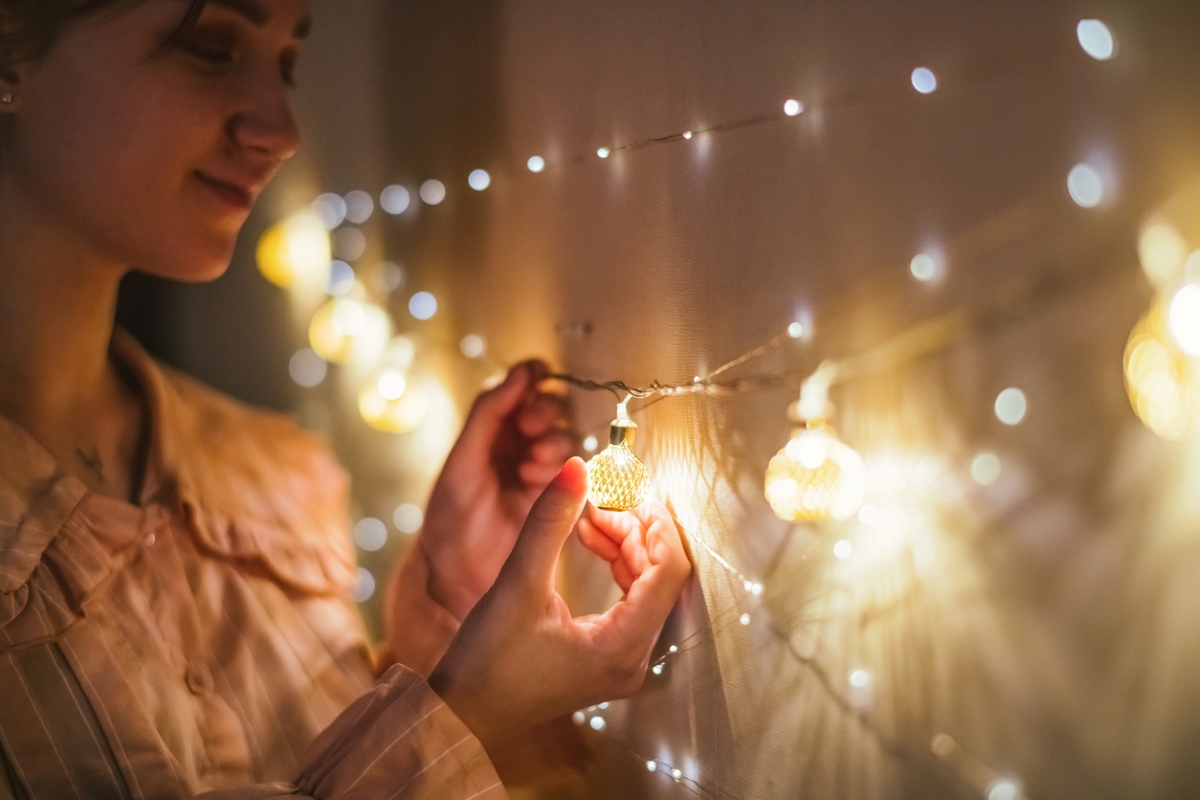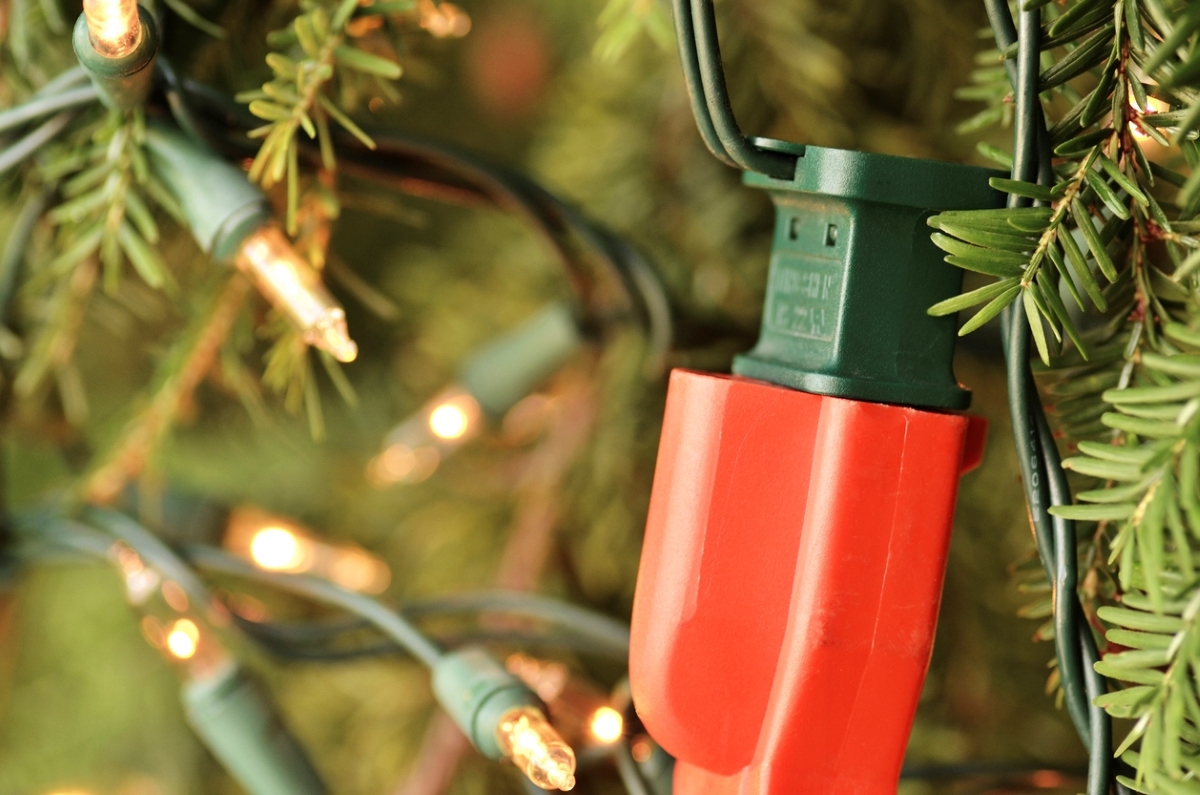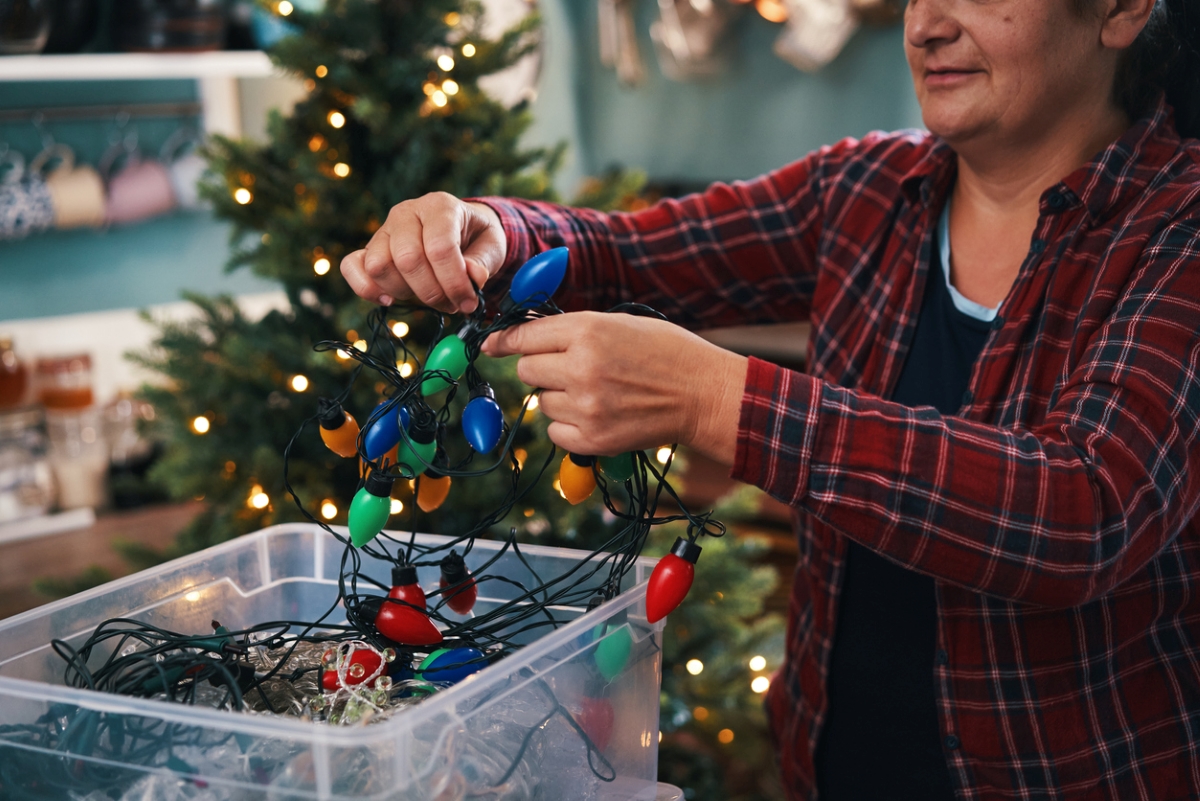

We may earn revenue from the products available on this page and participate in affiliate programs. Learn More ›
If avoiding frustration and preserving your holiday spirit are at the top of the wish list this holiday season, learning how to fix Christmas lights that are on the fritz might not seem to be worth the time. It’s a discouraging and sometimes fruitless task during an undeniably busy season, but it’s the price you may need to pay for a festive light display.
We tapped master electrician Adam Nelson, a cofounder of Tampa Bay-based Young Cardinal Electric with over a decade of experience in electrical work, for some expert tips on troubleshooting Christmas lights. He stresses the importance of buying the right products in the first place: “The biggest mistake people make is the use of extension cords and dividers/plug strips that are not rated for outdoor use,” Nelson says. “This causes the devices to melt and breakers to trip.”
Read on for the most common causes of, and the easiest solutions to, problems with Christmas tree lights. Note that for your own safety, before attempting to fix them, check twice that the lights are unplugged.
RELATED: The Best Christmas Lights to Brighten the Holiday Season, Tested
Troubleshooting Christmas Lights
String lights can fail for many reasons, but with these quick steps to troubleshooting and repairing Christmas lights, you’ll soon be able to identify the problem.
1. Verify that the outlet has power.
When trying to fix Christmas tree lights, start with the simplest possible cause: Make sure there is power at the electrical outlet. (If you don’t have a pen tester, try plugging in another string of lights that you know work.) If there isn’t any power at the outlet, check first to see if the outlet is controlled by a switch before heading to the breaker box.
2. Check for a blown Christmas light fuse.
If the outlet is fine, move on to check the fuses. In most Christmas lights, fuses—usually two of them for each string—are hidden behind a sliding door in the plug. You may be able to tell by sight which fuse is blown: Sometimes you will be able to see a break in the filament of a blown fuse, or the fuse will look a little brown or burned.
3. The problem might be a break in the wiring.
If the string doesn’t light with fresh fuses in the plug, the issue is either a burned-out bulb or a break in the wiring. Keep reading to learn more about these issues and what you can (and can’t) do about them.
4 Quick Fixes for Christmas Lights That Aren’t Working
Repairing Christmas lights can be a tedious job, but if you’re trying to make do with what you have, you may be able to fix a strand or two. Just be sure to have a hot cup of holiday cheer nearby—you might need it.

How to Replace a Christmas Light Bulb
Before replacing any bulbs, first confirm that every bulb is firmly seated in its socket. If every bulb is properly inserted but the string still doesn’t light properly, you may need to replace a bulb or two.
In some strings of lights, every bulb must be functional for the current to run the full length of the string. A single burned-out bulb will compromise the entire string, and finding the culprit can take time. You can use a multimeter to make quick work of locating the point at which the current is interrupted. Additionally, Nelson recommends the LightKeeper Pro, a tool that diagnoses and fixes Christmas string lights, which is available in both incandescent and LED versions.
Once you’ve identified the busted bulb, simply replace it with a new one to restore your display to its bright, shining glory. Replacement bulbs are typically included with each light string and are also available at hardware stores and home improvement centers, as well as via online retailers.
How to Change a Fuse in Christmas Lights
If you have a string of holiday lights that won’t turn on at all, you may need to replace a fuse. Most holiday light kits come with a few replacement fuses, but if you’ve already used (or lost) them, you can buy a set of replacement fuses. Just make sure you buy fuses that match your existing fuses.
Learning how to change a fuse in Christmas lights is easy—there’s no need for a soldering iron or other special tools. The fuses sit behind a small sliding door in the male-side plug. To change a fuse in Christmas lights:
- Unplug the string of lights from the outlet.
- Slide open the little door on the plug, carefully remove the old fuse with a small screwdriver, and then insert the new one.
How to Fix Flickering Christmas Lights
Flickering lights may be an indication that the electrical outlet can’t handle the wattage demands of your design. Have a look in your breaker box and check the amp capacity for the breaker that controls the outlet in question. To determine the maximum wattage for that circuit, multiply the amp value shown on the breaker (which in the U.S. is usually 15 or 20 amps) by the voltage (typically 120). Because electricians recommend not exceeding 80 percent of a circuit’s capacity, that gives you approximately 1,400 watts for a 15-amp circuit and 1,900 watts for a 20-amp circuit. Add up the wattage of all the light strings that are plugged into the outlet. (The wattage may be indicated on the packaging and may also be printed on a tag near the UL tag.) Be sure to take into account anything plugged into other outlets that are on the same circuit. If you have maxed out the juice on your outlet, cut back your display or consider supplementing it with solar-powered Christmas lights. Solar lights require zero electricity, so you can use as many strings as you like.

How to Deal With Lights That Won’t Stay On
Christmas lights are tailor-made to be strung together, but if you link too many in a chain, all of that holiday spirit can overwhelm your electrical outlet, and the lights may go out.
This problem can usually be fixed by reducing the number of light strings or by dividing the lights among two different outlets.
Another option is to purchase a holiday light splitter, a handy accessory that evenly distributes electrical current. A splitter enables you to add more strings to your holiday display when you don’t have multiple outlets.
Proper Maintenance for Christmas Tree Lights
Your holiday lights will shine brightly all season long, and be ready to do it all over again next year, if you care for them properly. Unlike fixing Christmas lights, maintaining them is pretty straightforward.

During the Season
- Use the right types of Christmas lights for the location. Indoor-rated lights aren’t weather-resistant and can’t handle the cold outdoor temperatures, while outdoor lights work fine indoors but are more expensive. For both safety and economy, use indoor lights inside and outdoor lights outside.
- Use plastic light clips instead of staples when attaching lights to your siding or trim. Staples can pinch and potentially damage wires, and they’re harder to remove.
- Don’t leave holiday lights on all day or overnight, whether indoors or out. All lights, regardless of the type, get warmer the longer they’re on. A timer or a smart plug with a programmable app can help moderate usage. Also, be sure to keep the Christmas tree watered to prevent it from becoming a safety hazard.
At the End of the Season
After the holidays, Christmas lights go from sources of cheer to just one more chore. To avoid damaging your lights while putting them away, follow these tips:
- Save the boxes they came in and reuse them at the end of the season to protect the individual strands.
- Don’t wrap Christmas lights into tight balls. Instead, purchase a Christmas light reel to keep them organized.

Storing Christmas Lights
The most important thing you can do to protect your Christmas lights is to avoid winding them too tightly. This can break wiring, crack bulbs, and tangle the wires, making them difficult to unwind next year.
While a Christmas light reel will help you wrap strings neatly and stow them tidily in a bag, there are also many DIY solutions for storing Christmas lights that take just a bit of creativity.
Finally, store your Christmas lights in the attic, basement, or garage, safely away from other items. If you’re constantly stepping over or walking around strings of lights, or moving other objects around near them, you’ll eventually damage them.
RELATED: Don’t Throw Your Old Christmas Lights in the Trash—Do This Instead
FAQs
You can absolutely string too many Christmas lights together, but how much is too many depends on a few factors, including whether they’re LED or incandescent, how many bulbs there are on each string, and how many watts each string draws. First, LED lights use far less electricity than incandescent, so it is generally safer to connect more LED strings together. The maximum number of strings that can be safely linked together is usually printed in the manufacturer’s instructions, which you should always follow. For incandescent lights, you can usually string together no more than five sets, but again, consult the manufacturer’s instructions.
Some light strings have a “twinkle” feature, which can be turned on by replacing a standard bulb with a special flasher bulb. If half of the string is unexpectedly flashing, you may have unintentionally replaced a bad bulb with a flasher bulb. Check the string for a flasher bulb—it will often have a red or silver tip—and replace it with a standard bulb. If this doesn’t fix the flashing, make sure the plug is making good contact with the outlet. If neither solution works, there may be a problem with the string’s wiring and it may be time to buy a replacement.
It’s possible, but it generally isn’t a good idea. Most Christmas lights are wired in series, and there may be several series in one strand. The best way to shorten these lights is to cut between two series, or at the point where there are only two wires (as opposed to three). Unplug the light string, cut these two wires, and use wire nuts to cap them off. Be aware that if you shorten your lights, you could risk causing an electrical fire or shock, so it isn’t advised.
